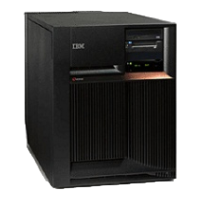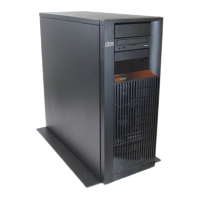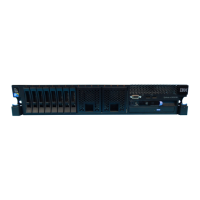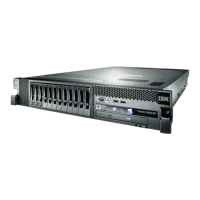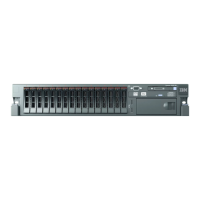problem (see System reference codes) before performing an IPL. Contact your next level of support
as necessary for assistance with SCSI bus problem isolation. If the problem is not corrected, continue
with the next step.
3. Perform an IPL to dedicated service tool (DST) (see Dedicated Service Tools (DST) in the iSeries
Service Functions
information).
Does an SRC appear on the control panel?
v No: Does either the Disk Configuration Error Report, the Disk Configuration Attention Report, or the
Disk Configuration Warning Report display appear?
– Yes: Continue with the next step.
– No: Go to step 5 (See page 106).
v
Yes: Go to step 6 (See page 106).
4. Does one of the following messages appear in the list?
v Missing disk units in the configuration
v Missing mirror protection disk units in the configuration
v Device parity protected units in exposed mode
– No: Continue with the next step.
– Yes: Select option 5, press F11, and then press Enter to display the details.
If all of the reference codes are 0000, go to “LIC-PIP11” on page 123 and use cause code
0002. If any of the reference codes are not 0000, go to step 6 (See page 106) and use the
reference code that is not 0000.
Note: Use the characters in the Type column to find the correct reference code table.
5. Does the Display Failing System Bus display appear?
v No: Look at all the Product activity logs by selecting Product activity log under DST (see
Dedicated Service Tools (DST) in the iSeries Service Functions
information). If there is more
than one SRC logged, use an SRC that is logged against the IOP or IOA.
Is an SRC logged as a result of this IPL?
– Yes: Continue with the next step.
– No: You cannot continue isolating the problem. Use the original SRC and exchange the failing
items, starting with the highest probable cause of failure (see the failing item list for this
reference code in the System reference code tables). If the failing item list contains FI codes,
see “Failing items” on page 249 to help determine part numbers and location in the system.
This
ends the procedure.
v
Yes: Use the reference code that is displayed under Reference Code to correct the problem.
This ends the procedure.
6. Record the SRC on the Problem summary form (see Problem summary form).
Is the SRC the same one that sent you to this procedure?
v Yes: Continue with the next step.
v No: Go to “Starting point for all problems” on page 2 to correct the problem.
This
ends the procedure.
7. Perform the following:
a. Power off the system or expansion tower. See Power on/off the system and logical partitions.
b. See “Failing items” on page 249 to find the devices identified by FI code FI01106.
c. Disconnect one of the disk units, (other than the load-source disk unit), the tape units, or the
optical storage units that are identified by FI code FI01106. Slide it partially out of the system.
Note: Do not disconnect the load-source disk unit, although FI code FI01106 may identify it.
8. Power on the system or the expansion tower that you powered off.
Does an SRC appear on the control panel?
106 iSeries: iSeries Server 270, 800, 810, 820, 825, 830, 840, 870, 890, SB2, and SB3 Hardware Problem Analysis and
Isolation
